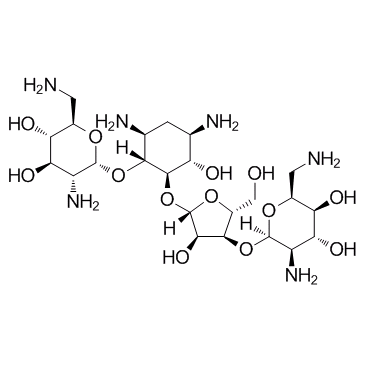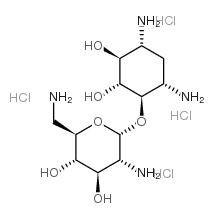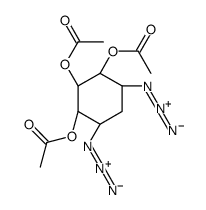119-04-0
| 中文名 | 新霉素B |
|---|---|
| 英文名 | framycetin |
| 中文别名 | 新霉素溶液 |
| 英文别名 |
soframycine
framygen enterfram soframycin NEOMYCIN B actilin antibiotique actiline EINECS 204-292-2 Neomycin solution |
| 描述 | Framycetin (Fradiomycin B; Neomycin B)是一种氨基糖苷类抗生素。抑制锤头核酶的Ki值为13.5 μM。 |
|---|---|
| 相关类别 | |
| 靶点 |
Ki: 13.5 μM (hammerhead ribozyme)[1] |
| 体外研究 | 临床上使用新霉素B来治疗肝性脑病(通过降低肠道中的铵水平)和肠致病性大肠杆菌感染。新霉素B靶向细菌和人类核糖体并影响翻译。向HCC细胞系添加新霉素B选择性地抑制成熟miRNA的产生,促进下游蛋白质并抑制侵袭[2]。新霉素B与不具有一级序列同源性的各种靶RNA相互作用。这意味着药物结合RNA的结构而不是序列基序。它的主要同源靶标是16S rRNA的解码位点,但它也与HIV-1,I组内含子和锤头状核酶中的Rev-反应元件结合,从而抑制其生物学功能[3]。氨基糖苷类抗生素新霉素B在翻译过程中诱导遗传密码的误读并抑制几种核酶。新霉素B的核糖体靶位点是16S rRNA1400至1500区域,已经通过从27个核苷酸的小RNA解剖该结构域清楚地证明了这一点。这种16 S rRNA的小亚结构域受到新霉素的化学修饰保护,其位置与30 S亚基相同[4]。 |
| 参考文献 |
[1]. Stage TK, et al. Inhibition of the hammerhead ribozyme by neomycin. RNA. 1995 Mar;1(1):95-101. |
| 密度 | 1.61 g/cm3 |
|---|---|
| 沸点 | 927.1ºC at 760 mmHg |
| 分子式 | C23H46N6O13 |
| 分子量 | 614.64400 |
| 闪点 | 514.5ºC |
| 精确质量 | 614.31200 |
| PSA | 353.11000 |
| 外观性状 | 透明液体 |
| 折射率 | 1.6000 (estimate) |
| 储存条件 | 2-8°C |
| 分子结构 | 1、 摩尔折射率:142.89 2、 摩尔体积(cm3/mol):380.3 3、 等张比容(90.2K):1214.3 4、 表面张力(dyne/cm):103.9 5、 极化率(10-24cm3):56.64 |
Synonym:Framycetin Sulphat Section 2 - COMPOSITION, INFORMATION ON INGREDIENTS
Risk Phrases: None Listed. Section 3 - HAZARDS IDENTIFICATION EMERGENCY OVERVIEW
Hygroscopic (absorbs moisture from the air).The toxicological properties of this material have not been fully investigated. Potential Health Effects Eye: May cause eye irritation. The toxicological properties of this material have not been fully investigated. Skin: May cause skin irritation. The toxicological properties of this material have not been fully investigated. Ingestion: May cause irritation of the digestive tract. The toxicological properties of this substance have not been fully investigated. Inhalation: May cause respiratory tract irritation. The toxicological properties of this substance have not been fully investigated. Chronic: No information found. Section 4 - FIRST AID MEASURES Eyes: Flush eyes with plenty of water for at least 15 minutes, occasionally lifting the upper and lower eyelids. Get medical aid. Skin: Get medical aid. Flush skin with plenty of water for at least 15 minutes while removing contaminated clothing and shoes. Wash clothing before reuse. Ingestion: Never give anything by mouth to an unconscious person. Get medical aid. Do NOT induce vomiting. If conscious and alert, rinse mouth and drink 2-4 cupfuls of milk or water. Inhalation: Remove from exposure and move to fresh air immediately. If not breathing, give artificial respiration. If breathing is difficult, give oxygen. Get medical aid. Notes to Physician: Section 5 - FIRE FIGHTING MEASURES General Information: As in any fire, wear a self-contained breathing apparatus in pressure-demand, MSHA/NIOSH (approved or equivalent), and full protective gear. During a fire, irritating and highly toxic gases may be generated by thermal decomposition or combustion. Extinguishing Media: In case of fire, use water, dry chemical, chemical foam, or alcohol-resistant foam. Use agent most appropriate to extinguish fire. Do NOT get water inside containers. Use water spray, dry chemical, carbon dioxide, or appropriate foam. Section 6 - ACCIDENTAL RELEASE MEASURES General Information: Use proper personal protective equipment as indicated in Section 8. Spills/Leaks: Clean up spills immediately, observing precautions in the Protective Equipment section. Sweep up or absorb material, then place into a suitable clean, dry, closed container for disposal. Provide ventilation. Do not get water inside containers. Section 7 - HANDLING and STORAGE Handling: Wash thoroughly after handling. Remove contaminated clothing and wash before reuse. Use with adequate ventilation. Avoid contact with eyes, skin, and clothing. Keep container tightly closed. Avoid ingestion and inhalation. Do not allow contact with water. Keep from contact with moist air and steam. Storage: Store in a tightly closed container. Store in a cool, dry, well-ventilated area away from incompatible substances. Store protected from moisture. Section 8 - EXPOSURE CONTROLS, PERSONAL PROTECTION Engineering Controls: Use adequate ventilation to keep airborne concentrations low. Exposure Limits CAS# 119-04-0: Personal Protective Equipment Eyes: Wear appropriate protective eyeglasses or chemical safety goggles as described by OSHA's eye and face protection regulations in 29 CFR 1910.133 or European Standard EN166. Skin: Wear appropriate protective gloves to prevent skin exposure. Clothing: Wear appropriate protective clothing to prevent skin exposure. Respirators: Follow the OSHA respirator regulations found in 29 CFR 1910.134 or European Standard EN 149. Use a NIOSH/MSHA or European Standard EN 149 approved respirator if exposure limits are exceeded or if irritation or other symptoms are experienced. Section 9 - PHYSICAL AND CHEMICAL PROPERTIES Physical State: Liquid Color: Not available. Odor: None reported. pH: Not available. Vapor Pressure: Not available. Viscosity: Not available. Boiling Point: Not available. Freezing/Melting Point: Not available. Autoignition Temperature: Not available. Flash Point: Not available. Explosion Limits, lower: Not available. Explosion Limits, upper: Not available. Decomposition Temperature: Solubility in water: 6.3 mg/ml (28 c) Specific Gravity/Density: Molecular Formula: C23H46N6O13.3H2SO4 Molecular Weight: 908.89 Section 10 - STABILITY AND REACTIVITY Chemical Stability: Stable under normal temperatures and pressures. Conditions to Avoid: Incompatible materials, moisture, strong oxidants. Incompatibilities with Other Materials: Oxidizing agents. Hazardous Decomposition Products: Nitrogen oxides, carbon monoxide, oxides of sulfur, irritating and toxic fumes and gases, carbon dioxide, nitrogen. Hazardous Polymerization: Has not been reported. Section 11 - TOXICOLOGICAL INFORMATION RTECS#: CAS# 119-04-0: QP4025000 LD50/LC50: CAS# 119-04-0: Oral, mouse: LD50 = 1250 mg/kg. Carcinogenicity: Neomycin B Sulfate - Not listed by ACGIH, IARC, or NTP. Other: See actual entry in RTECS for complete information. Section 12 - ECOLOGICAL INFORMATION Section 13 - DISPOSAL CONSIDERATIONS Dispose of in a manner consistent with federal, state, and local regulations. Section 14 - TRANSPORT INFORMATION IATA Not regulated as a hazardous material. IMO Not regulated as a hazardous material. RID/ADR Not regulated as a hazardous material. Section 15 - REGULATORY INFORMATION European/International Regulations European Labeling in Accordance with EC Directives Hazard Symbols: Not available. Risk Phrases: Safety Phrases: S 24/25 Avoid contact with skin and eyes. S 28A After contact with skin, wash immediately with plenty of water. S 37 Wear suitable gloves. S 45 In case of accident or if you feel unwell, seek medical advice immediately (show the label where possible). WGK (Water Danger/Protection) CAS# 119-04-0: 2 Canada None of the chemicals in this product are listed on the DSL/NDSL list. CAS# 119-04-0 is not listed on Canada's Ingredient Disclosure List. US FEDERAL TSCA CAS# 119-04-0 is not listed on the TSCA inventory. It is for research and development use only. SECTION 16 - ADDITIONAL INFORMATION N/A |
CHEMICAL IDENTIFICATION
HEALTH HAZARD DATAACUTE TOXICITY DATA
|
| 危害码 (欧洲) | Xn: Harmful; |
|---|---|
| 风险声明 (欧洲) | R42/43 |
| 安全声明 (欧洲) | S26;S45;S36/S37/S39 |
| WGK德国 | 2 |
| 上游产品 0 | |
|---|---|
| 下游产品 4 | |






